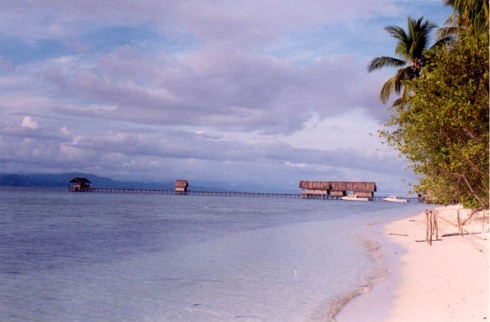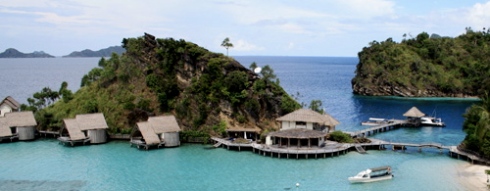By Dian Hasan | July 15, 2010

Komodo, the world’s largest monitor lizard, can grow up to 3m long. One dragon can bring down a buffalo with a single, poisonous bite. They can run up to 18 km an hour, and have anything for dinner (incl. humans! Tourists beware! There have been missing tourists in the past).
Arguably, Indonesia’s tourism industry might not be as well developed as some of her Southeast Asian neighbors, and that is of course not due to a lack of attractions. After all, Indonesia is home to Bali, her crown jewel tourism magnet. Indonesia’s entire modern tourism industry seemingly is centered on Bali, leaving other areas relatively undeveloped.
In the past, such condition may have been considered to be behind the times, but in the advent of raised awareness regarding sustainability and eco-consciousness, this is Indonesia’s blessing. For this vast archipelago, with the world’s second richest rainforest biodiversity after the Amazon, is most probably the world’s last eden! An endangered eden that is fast disappearing. And it’s up to us all to strive for a sustainable development that champions economic progress without compromising natural resources for future generations.
It is outside Bali, in the unexplored corners of Sumatra, Borneo and Eastern Indonesia, where Indonesia’s greatest gift to mankind is being conserved – her fauna and flora. The Komodo “dragon” monitor lizard, Orangutan, Java Rhino, Sumatran Elephant, Rhino and Tiger are just some of the more famous residents – whose habitat can only be found in Indonesia. The fate and survival of these endangered species depend on the global community coming together with the right initiatives.
And while Indonesia is not immune from a tug-o-war between economic growth and conservation and sustainable efforts, it is a balancing act that Indonesia is starting to take seriously, with the help of various international organizations.

Ecotourism is one way, in which these efforts are executed, raising awareness of the animals’ plight, and helping generate much-needed revenue to help with conservation efforts, while practicing responsible tourism.
Eco Lodges Indonesia (ELI) is a pioneering, ecotourism provider operating in an emerging economy, with a focus on biodiversity conservation and enhancement of local community livelihoods. Eco Lodges Indonesia runs four ecolodges in Indonesia’s major National Parks, and partakes in the protection of these endangered animals. The other objective is to improve the livelihoods of local communities where the properties are located.
Eco Lodges Indonesia is one of the first to pursue international sustainable tourism certification in Indonesia, and is committed to achieving the UN Millennium Development Goals through their ecotourism investments and operations.
Bajo Komodo Eco Lodge, Komodo National Park, Komodo Island, East Indonesia

Bajo Komodo Eco Lodge is situated near Labuan Bajo on Flores Island. It is the only hotel of its type close to the Komodo National Park, a World Heritage Site.
Alternative accommodation is available in simple wooden beach bungalows on Seraya Island and Kanawa Island, just off of Komodo Island. Both of them are charming, offering a back-to-nature getaway, although food options at the latter is rather limited.
Bajo Komodo Eco Lodge combines good accommodation, service and cuisine with the ideal opportunity to view the Komodo Dragon giant monitor lizard, and dive, snorkel or view birds in one of the most beautiful coral and island areas on the globe. The Lodge has mosquito proof rooms with AC, en-suite bathrooms with hot water, IDD phone and a desk with chairs.
It also has a swimming pool, bar and restaurant here you can view magnificent sunsets. The staff are all local people giving it a special atmosphere. Room rates include airport or port transfers, breakfast and daily laundry. We also have a vehicle hire service for local or Trans Flores safaris.




The lodge features the island’s best amenities, including: 8 rooms with AC, fan, hot water and phone, complimentary breakfast, swimming pool, free airport transfers, free daily laundry, a restaurant serving three meals per day at reasonable prices, a bar, bottled drinking water supplied.
Also includes information, books and binoculars for bird and butterfly watching, affordable vehicle hire with modern vehicles and experienced drivers, masks/snorkels for hire (no fins), storage area for diving gear, tour information to Komodo National Park, boat pick-up from the beach for snorkelling, diving or river safari.
Eco Lodge Indonesia operates all their properties in accordance to the “six pillars of eco tourism” as suggested by The University of Western Sydney:
1. Depends on the natural environment
2. Ecologically sustainable
3. Proven to contribute to conservation
4. Features an environmental training program
5. Incorporates cultural considerations
6. Provides a net economic return to the local community. Continue reading →





 If the first thing that struck you was the hotel’s decidedly Euro-skewed name, you paid attention well.
If the first thing that struck you was the hotel’s decidedly Euro-skewed name, you paid attention well. 
































































































 Elevated and crafted along an idyllic island beach,
Elevated and crafted along an idyllic island beach,